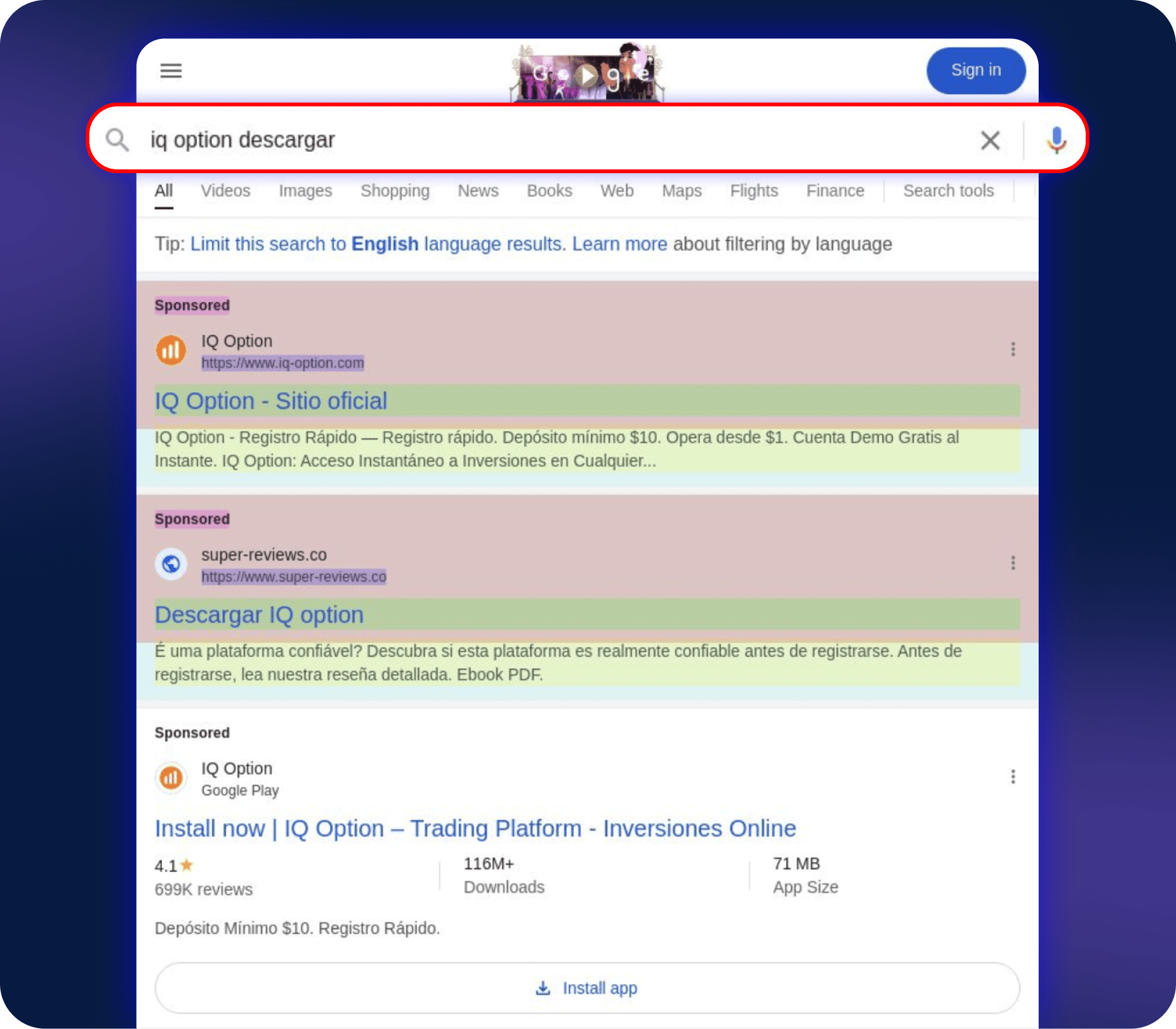
Contents
Affiliate fraud and competitors’ violations are major problems in digital marketing today. Dishonest affiliates and competitors use different tactics to manipulate traffic and earn as much as possible without second thought. Their unethical practices hurt businesses by decreasing revenue and damaging brand reputation. Trademark infringement is one of the issues that can arise without thorough brand monitoring. Trademark abuse happens when some company uses a trademark that is identical or very similar to a registered trademark of another brand.
Trademark violations are not that easy to catch, though. In this article, we will learn how to identify Google trademark infringement and provide practical steps to resolve trademark violations. We will cover the signs of them and the options available to address the problem. Especially, how to make a Google Ads trademark complaint. Additionally, we will explore the importance of regular brand search monitoring and how to use modern tools to keep your brand safe.
Whether you are a digital marketer or a business owner, this article will give you useful tips on handling trademark disputes. By staying proactive and informed, you can ensure your brand remains unique and protected in the competitive market.
What is Trademark Infringement
As it was said earlier, trademark infringement is the unauthorized use of a trademark that is either identical or deceptively similar to a registered trademark.
In digital marketing, trademark violations often involve:
- • PPC advertising. Using trademarked terms in online advertising to direct users to a competing product or service, making it look like the ad is related to the trademark owner.
- • Domain names. Registering a domain name that is very similar to a well-known brand's name, which could confuse users into thinking the site is affiliated with or endorsed by the brand. This technique is also known as URL-hijacking.
- • Content. Copying or closely imitating a brand’s logo, slogan, or other trademarked elements in online content, such as social media posts, websites, or email marketing, in a way that could mislead users.
These actions can lead to legal disputes if the brand owner believes that their trademark rights are being violated and that consumers are being misled.
Trademark infringement is dangerous for businesses for several reasons.
Firstly, trademark violations can result in losing search engine ranking. Google’s algorithms are designed to detect duplicate content by comparing text and other elements across different pages and websites. So, if someone uses your trademark, your own website can be considered to contain duplicate content. This leads to lower rankings, affecting your traffic in a bad way.
Secondly, trademark infringement leads to the decline in organic traffic. It happens because users who search for your brand in Google see your affiliates’ or even competitors’ ads. They use your trademark in their copy, so that their ads are shown in your own branded search results. This is how brands lose their organic traffic which could bring them potential customers and profit.
Also, trademark violations can cause consumer confusion. When consumers encounter a product or service that uses a similar trademark, they may mistakenly believe it is associated with or endorsed by the legitimate brand. This confusion can damage the original brand's reputation if the infringing product is of lower quality or associated with negative experiences.
Finally, trademark infringement weakens the value of the brand. A strong, distinctive trademark helps build a brand's identity and consumer trust. When others use a similar trademark, it weakens the brand's uniqueness and can diminish its market value. This makes it harder for consumers to distinguish between the genuine brand and imitations, ultimately reducing the brand's competitive edge.
As you see, trademark infringement is a serious issue that can harm businesses through consumer confusion and financial loss. Protecting trademarks is crucial for maintaining a brand's reputation and market position. Businesses must be vigilant in monitoring and defending their trademarks to ensure their long-term success.
Identifying the Trademark Infringement
Manual monitoring is a sensible first step in addressing trademark infringement. By conducting thorough, hands-on checks, you can identify potential violations early on and assess the context in which your trademark is being used. To manually detect Google trademark infringement, start by regularly searching for your brand name and related keywords. Look for unauthorized use of your trademark in ads, websites, and social media profiles. Pay close attention to PPC advertising and the keywords that are used in the ads. Try to notice even some slight variations in spelling that could confuse consumers.
Despite these efforts, spotting all trademark violations manually is difficult due to the advanced methods competitors use to hide their violations. They might run ads in limited geographic areas or during nighttime hours to avoid detection. These tactics make it challenging to identify violations through manual monitoring alone.
Given these complexities, it is essential to use automated services for monitoring advertisements. These tools can scan SERPs from different GEOs, devices, and browsers to detect unauthorized use of your trademark in real-time. Automated services provide alerts and detailed reports, making it easier to take swift action against violators.
How to Identify the Trademark Infringement in 10 sec
Bluepear monitors your branded search 24/7 from different GEOs, devices, and browsers, ensuring that any unauthorized use of your trademark is immediately flagged. Also, Bluepear sends real-time notifications, so that you can take quick actions. The tool provides comprehensive reports that include evidence of infringement, such as screenshots and URLs. This documentation is crucial when submitting complaints to platforms like Google. This is how you can identify the trademark infringement in 10 seconds with Bluepear:
1 - Go to the Paid Results page under the SERP Monitoring tab.

2 - In Policy, select Trademark abuse. You will see a list of your affiliates’ ads that use your brand name.

3 - Navigate to Ad Overview. On this page, you can view the keywords used, the date and time the ad was detected, and its position in the search results.

4 - Open Bluepear’s report with all the needed URLs, IDs, and screenshots combined in one document. Now you have evidence of the infringements, which makes it easier to present proof to the violators.
5 - Send the evidence to the infringer or to the search engine to protect your trademark.
With Bluepear, you do not need to waste your time on monitoring your branded search and seeking for trademark (or any other) violations. Just a few clicks are needed to protect your brand from being abused by dishonest affiliates and competitors.
How To Submit a Trademark Complaint to Google
If you need to report a trademark infringement to Google, you can make a trademark complaint and send it through the official Google Trademark Complaint form or by emailing [email protected].
To submit a trademark complaint to Google, you must have a registered trademark in the country where the ad was found. If your trademark is not registered, they may still accept Google Ads trademark complaints for well-known brands in common law countries (e.g., US, UK, Australia).
Here's how to submit a Google Ads trademark complaint:
Step 1. Gather necessary information
Before you begin, collect all relevant information and evidence to support your trademark complaint.
This includes:
- • Links to the infringing ads or websites.
- • Screenshots of the infringing content.
- • Your trademark registration documentation.
- • Your contact information.
Step 2. Access the trademark complaint page
Visit the Official Google Trademark Complaint form. Alternatively, you can email your complaint to [email protected].
Step 3. Fill out the form
In the form, you will need to provide:
- • Your contact information. If you are not the trademark owner, you must document your permission and relation to the trademark owner.
- • Evidence of the infringement, such as links, images, and your trademark registration documentation.
Step 4. Submit the form
After completing the form with all required information, submit it to Google.
Step 5: Wait for Google's response
Once submitted, Google reviews the complaint to ensure the ads violate their trademark policy. This process can take 1-8 weeks. Google will inform you of any actions taken or explain why they did not act, providing links to their policies.
Google's representatives manually review these complaints, which can take between one to eight weeks. Monitor your email, as a Google representative might contact you for additional information.
By following these steps, you can effectively submit a trademark infringement complaint to Google, helping to protect your brand from unauthorized use.
Protect Your Brand in Advance with Bluepear
Protecting your brand from Google trademark infringement is crucial in maintaining its integrity, reputation, and market position. While manual monitoring methods and reactive measures are important, proactive strategies can provide a more robust defense against potential violations. One of the most effective ways to safeguard your brand is using an automated monitoring tool like Bluepear.
By incorporating Bluepear into your brand protection strategy, you will ensure that your trademark and your brand reputation remains secure. With Bluepear, you can proactively defend your brand against trademark infringement. The tool's ability to detect and report violations quickly minimizes the risk of consumer confusion and financial loss.
FAQ
What is trademark infringement in digital advertising?
It’s the unauthorized use of a protected brand name or elements in ads, domains, or content in a way that may mislead users or damage the brand.
How can I quickly spot trademark violations in Google Ads?
Check branded queries for suspicious ads, unusual copy, misleading URLs, or placements you didn’t authorize. Automated monitoring tools reveal hidden violations faster.
What evidence is required for a Google trademark complaint?
Links to infringing ads, screenshots, trademark registration proof, and your contact details. Google reviews cases manually, so detailed evidence matters.
Can Google act if my trademark isn’t registered?
In some regions, yes. Google may still process complaints for well-known brands in common-law countries, but outcomes are less predictable without registration.
Why do some violations stay invisible during manual checks?
Violators often hide ads behind GEO targeting, night-time schedules, or device filtering, making them hard to catch without automated 24/7 scanning.
How does Bluepear help with trademark infringement detection?
It monitors branded search from multiple GEOs, devices, and browsers, flags unauthorized ads, collects evidence, and compiles ready-to-send reports.
What happens after filing a Google trademark complaint?
Google reviews the case within several weeks. If a violation is confirmed, infringing ads may be restricted or removed across the relevant markets.

